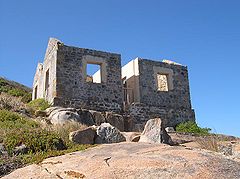The coastline of the Albany area was observed by Europeans for the first time in 1627 by the Dutchman François Thijssen, captain of the ship 't Gulden Zeepaert (The Golden Seahorse), who sailed to the east as far as Ceduna in South Australia and back. Captain Thijssen had discovered the south coast of Australia and charted about 1,768 kilometres (1,099 mi) of it between Cape Leeuwin and the Nuyts Archipelago.[1][2]
On 29 September 1791, explorer Captain George Vancouver while exploring the south coast on HMS Discovery, entered and named King George the Third's Sound and Princess Royal Harbour, and took possession of New Holland for the British Crown. Vancouver went out of his way to establish good relationships with the local Aboriginal people.[3][4]


In 1792, Frenchman Bruni d'Entrecasteaux, in charge of Recherche and L'Esperance, reached Cape Leeuwin on 5 December and explored eastward along the southern coast. The expedition did not enter King George Sound due to bad weather.
In 1801, Matthew Flinders entered King George Sound and stayed for about a month before charting the rest of the southern Australian coastline. By 1806 he had completed the first circumnavigation of Australia.
French explorer Nicolas Baudin visited King George Sound from 18 February – 1 March 1803, in Géographe and Casuarina. He surveyed Princess Royal Harbour, Oyster Harbour and the coast as far as Bald Island, to the east. During this visit, Casuarina was beached in Princess Royal Harbour for repairs.[5]
Australian-born explorer Phillip Parker King visited King George Sound in 1822 on Bathurst.
- ^ McHugh, Evan (2006). 1606: An Epic Adventure. Sydney: University of New South Wales Press. pp. 44–57. ISBN 978-0-86840-866-8.
- ^ Garden 1977, p.8.
- ^ Vancouver, George (1798). "2". A Voyage of Discovery to the North Pacific Ocean, and Round the World. Vol. 1. London: G.G. & J. Robinson. p. 35.
- ^ Garden 1977, p.9.
- ^ Baudin, Nicolas (trans. Christine Cornell), The Journal of Post Captain Nicolas Baudin, Libraries Board of South Australia, Adelaide, 1974.